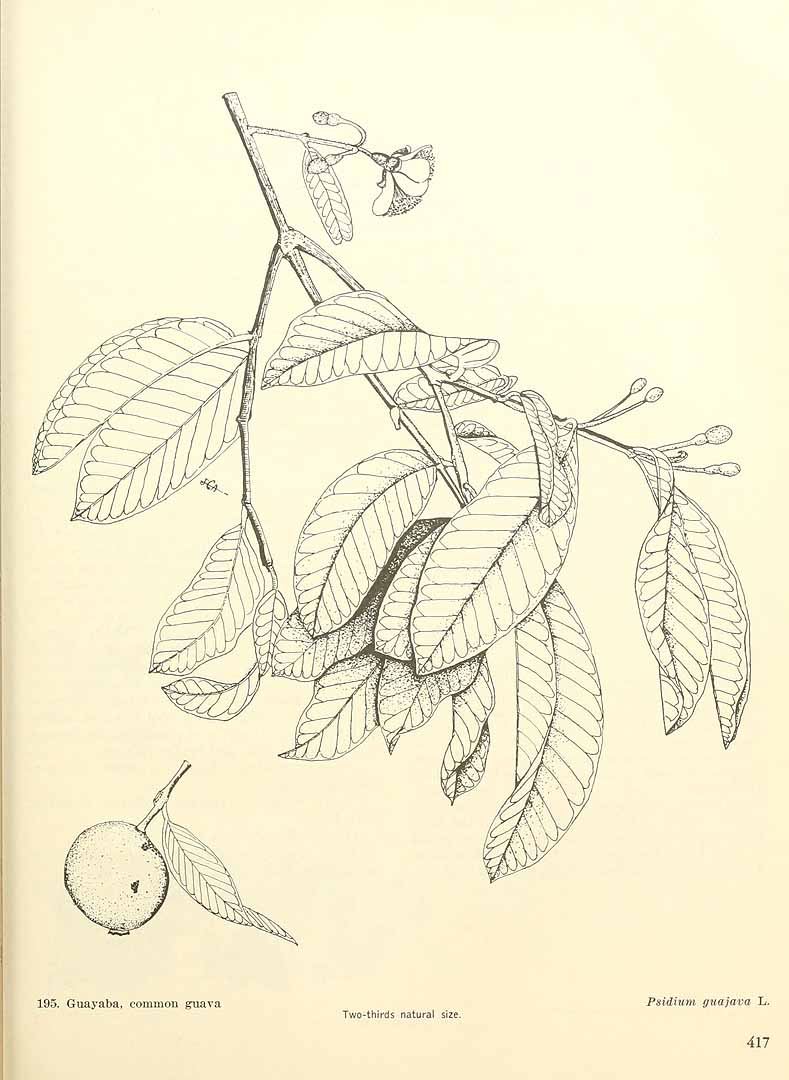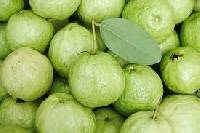Family: Myrtaceae
Guava, more..., common guava, lemon guava, yellow guava, (portuguese: goiaba), (spanish: guayaba), (tongan: kuava)
A shrub or small tree; bark smooth, light reddish-brown, with pubescent 4- angled young branches; leaves opposite, ovate-elliptic or oblong-elliptic, acuteacuminate, pubescent beneath, often rather brittle, prominently nerved, lateral nerves 10-20 pairs; blades mostly 7-15 em long and 3-5 em wide, rounded at base, dull green; flowers solitary or 2-4 together in leaf axils, rather large (2.5 em wide); peduncle about 1-2 em long, pubescent; calyx 4-5-lobed (anthesis, not before) about 6-8 mm long; petals white, 10-15 mm long, fugacious, usually 4 or 5, obovate, slightly concave; stamens numerous (c. 200-250), white, about as long as petals; style 10-12 mm long, stigma peltate; fruit globose, ovoid, or pyriform, whitishyellow or faintly pink, sweet-sour pulpy, many-seeded, 2.5-10 cm long; pulp granular juicy; seeds yellowish, reniform. A native of Tropical America, introduced very early to Guam by the Spanish galleons, thence to the Philippines and throughout Asia, where it is now common both in gardens and as a naturalized sometimes almost weedy shrub. Many varieties of horticultural interest exist; unfortunately most of the Guam plants seem to have rather inferior fruits. It is often encountered in abandoned fields, forming small thickets seldom over 2 m tall, with a thickish trunk. It is common in Hawaii, where it is used to make guava jams and jellies, and the juice is canned. Cetti Bay (3900); Barrigada (5130).
USES: Medicinal. Food. In a common folk remedy, an infusion of the young leaves is taken as a potion for treating stomachache (langa kete). The plant is likewise widely used in the Pacific as well as for treating diarrhea. Psidium guajava is native to tropical America, but is now widely distributed in the tropics. It was introduced to Tonga and the rest of Polynesia in the 19th century, and soon became a serious weed of open, disturbed places such as pastures, plantations, roadsides, and fallow land. The fruit is edible fresh, but because of the numerous hard seeds, it is much more suitable for making jam or juice. Although the tree was originally introduced for its fruit, it is now also known for its medicinal properties, the knowledge of which has spread from island to island in the Pacific. Its medicinal value is due mainly to the presence of tannin (up to 10% dry weight) in the bark, leaves, and leaf buds, which makes it useful as an astringent. The plant is a shrub or small tree up to 10 m in height, with 4-angled stems and bark that peels off in flakes. The simple, oppositely arranged leaves have an oval to elliptic blade 6‒15 cm long. The flowers, borne solitary in the leaf axils, have a corolla of five white petals 10‒15 mm long and numerous showy white stamens. The fruit is a yellow, globose to ovoid berry 5‒10 cm long, with many small, hard seeds embedded in the pink to yellow pulp.
|




